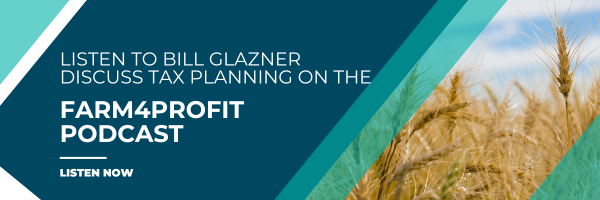Year-End Tax Planning for Farmers & Ranchers
Guiding Farmers and Ranchers Through Effective Tax Management
As we move towards the end of another challenging year, it’s time for farmers and ranchers to shift focus from the fields to the financials. The unpredictable nature of the past few years, marked by market fluctuations and unprecedented weather events, has underlined the importance of strategic planning, especially in the realm of taxes.
When considering year-end tax planning, it is important that farmers and ranchers not only consider the current tax year but also evaluate what makes sense for the long-term future of their operation.
Farm Income Averaging
Farm income averaging is a tool used to spread current year farm income out over the prior three years. This can be used to reduce tax liability when current year income is higher than income in one or more of the prior years. To learn more about farm income averaging, click here.
Deferral of Crop Insurance Proceeds
Farmers who receive income from crop insurance in the year of damage to the crop can defer the recognition of this income into the following year. This can be a powerful tool for farmers whose regular business practice is to sell crops in the year after harvest. It can help prevent showing two years’ worth of crop income in one tax year. For more information on the deferral of crop insurance proceeds, click here.
Deferral of Livestock Sales due to Disaster
As extreme weather conditions affect several areas of the U.S., farmers maybe be forced to sell livestock due to a lack of feed sources. When these forced sales occur, special tax provisions may allow farmers and ranchers to defer the income received on those sales. Click to learn two tax deferral strategies that farmers and ranchers could consider.
Bonus Depreciation & Section 179
Bonus depreciation is yet another year-end tax planning consideration. Farmers who purchased farm assets in the current year can accelerate the depreciation deduction for those assets. Bonus deprecation allows for an 80% write of qualified property placed in service in 2022.
Examples of qualified property include:
- Farm machinery
- Breeding livestock
- Grain bins
- Farm buildings
Section 179 is another method of accelerated depreciation. Section 179 differs from bonus depreciation in several ways. It is limited to $1,160,000 and that limit is reduced by $1 for every $1 over $2,890,000 sent on qualifying assets. It cannot be used to create a loss and can be applied on an asset-by-asset basis to any amount up to 100% of the purchase price. It is not available for multi-purpose farm buildings.
Deferred Payment Contract
A deferred payment contract is an installment sale where a cash basis farmer can sell crops in the current year but pay for the commodity until the following year through a deferred payment contract. While payment is deferred until next year, the taxpayer can realize the deferred payment as income in the current year or the following year on a contract-by-contract basis. This added flexibility can be a helpful planning tool. Read our Deferred Grain Contracts article for more information.
Prepaid Expenses
Cash basis farmers and ranchers can prepay for some supplies that can be deducted in the current tax year, but that will be used in the following tax year. Some examples of supplies that can be prepaid include:
- Feed
- Seed
- Fertilizers
- Similar farm supplies
The amount that can be prepaid is subject to some limitations. Learn more here.
Charitable Giving of Commodities
Farmers that are charitably inclined can gift a commodity such as grain or cattle. A commodity that is gifted to a charitable organization will not be taxed. Not only does this strategy save on income taxes, but it also saves farmers on self-employment taxes – a double benefit. This would provide a better tax benefit for active farmers, especially if they planned to donate to charity anyway. Learn more about eligibility and requirements for charitable giving of commodities here.
Questions?
All the above areas can be part of a productive discussion with your farm tax accountant. Contact Adams Brown’s agriculture team to discuss your situation.


